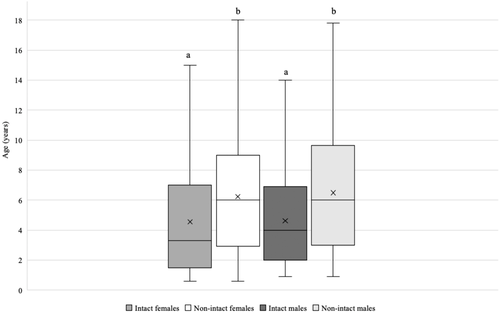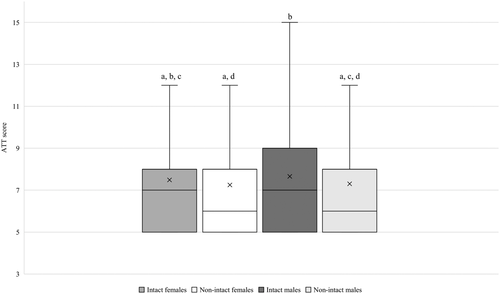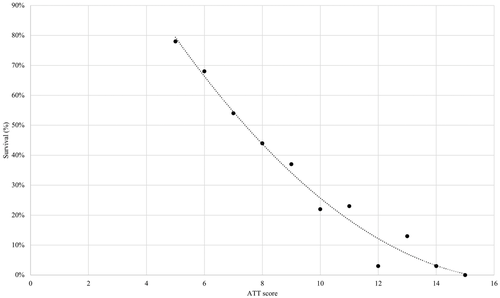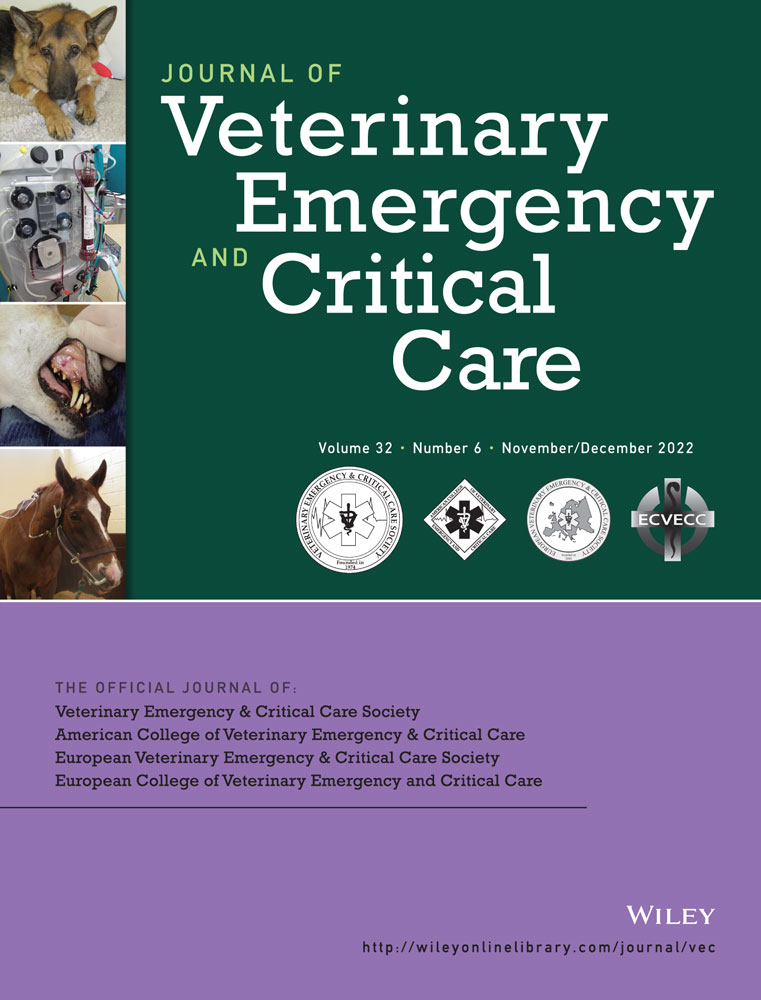The effects of sex and neuter status on trauma survival in dogs: A Veterinary Committee on Trauma registry study
Abstract
Objective
To determine the effect of sex and neuter status on trauma survival in dogs.
Design
Multi-institutional prospective case series, September 2013 to March 2019, retrospectively analyzed.
Setting
Level I and II Veterinary Trauma Centers.
Animals
Consecutive sample of 2649 dogs in the American College of Veterinary Emergency and Critical Care Veterinary Committee on Trauma patient registry meeting inclusion criteria. For inclusion, dogs had to have complete data entries, be postpubertal (≥7 months age in females and ≥10 months age in males), and have sustained moderate to severe trauma (animal trauma triage [ATT] score ≥5/18). Dogs that were dead upon arrival, euthanized for financial or unknown reasons alone, or that were presented by a Good Samaritan but subsequently humanely euthanized were excluded.
Measurements and Main Results
Data collected included age, sex, neuter status (intact, neutered), trauma type (blunt, penetrating, both), outcome (survived to hospital discharge, died, euthanized), and reason for euthanasia (grave prognosis, financial reasons, or both). Of 2649 eligible dogs, 56% survived to hospital discharge (n = 1469). Neutered females had a significantly higher survival rate (58.3% vs 51.3%; P = 0.03) compared to intact females, and neutered males had a significantly higher survival rate (56.6% vs 50.7%; P = 0.04) compared to intact males. There was no significant difference in survival between intact females and intact males (P = 0.87) or between neutered females and neutered males (P = 0.46). Mean cumulative ATT score was higher in intact groups and was found to be a significant predictor of survival (P < 0.01). Based on logistic models, overall odds of survival were 20.7% greater in neutered dogs.
Conclusions
Gonadectomy is associated with lower ATT scores and improved survival after moderate to severe trauma in both female and male dogs.
Abbreviations
-
- ACVECC
-
- American College of Veterinary Emergency and Critical Care
-
- ATT
-
- animal trauma triage
-
- VetCOT
-
- Veterinary Committee on Trauma
-
- VetCOT
-
- RS Veterinary Committee on Trauma – Registry Subcommittee
-
- VTC
-
- Veterinary Trauma Center
1 INTRODUCTION
The effect of gender on trauma survival in people is controversial, with most studies suggesting either a survival advantage for women or no effect.1-9 Few studies indicate a survival advantage for men.10 While poorly understood, explanations for any gender difference in human trauma survival are generally based on hormone-driven differences in physiological response.11-14 Unlike people, pet dogs frequently undergo gonadectomy and, as such, provide a model to clarify the effects of sex hormones on trauma survival. Previously, only 1 canine trauma study has reported a survival difference based on sex. In that study, intact and neutered females had 6 times greater odds of survival after thoracic trauma than that of intact and neutered males, but the cause of this dimorphism was not determined.15 A similar study in cats identified no association between sex and survival to discharge.16
The purpose of this study was to determine whether there is an effect of sex and neuter status on survival following traumatic injury in dogs. Specifically, we aimed to compare trauma survival of 4 sexually different groups of dogs: intact females, neutered females, intact males, and neutered males. Based on human and laboratory animal studies, and the single-dog study, we hypothesized that intact females would be associated with increased odds of survival.
2 METHODS
The American College of Veterinary Emergency and Critical Care (ACVECC) Veterinary Committee on Trauma (VetCOT) trauma registry is a formal collection of all dog and cat trauma cases that present to Level I and II Veterinary Trauma Centers (VTCs) across the country. The ACVECC established the Veterinary Committee on Trauma – Registry Subcommittee (VetCOT-RS) to manage all trauma patient data and to decide its use by other professionals. Veterinary professionals are encouraged to apply for and use these data with approval from the VetCOT-RS. Access to data in the ACVECC VetCOT trauma registry was applied for through their formal application process, which involved justification, literature review, and preliminary data analysis. The application was reviewed by 3 members of the VetCOT-RS and approved by obtaining a qualifying score.
The VetCOT computerized patient registry was searched for all dogs entered from September 1, 2013 to March 31, 2019. To be included in this study, dogs had to be postpubertal (≥7 months age in females and ≥10 months age in males) and have sustained moderate to severe trauma (animal trauma triage [ATT] score ≥5). ATT scores range from 1 to 18 based on criteria associated with increasing trauma.17
Data collected included age, sex, neuter status, ATT score, outcome (survived to hospital discharge, died, euthanized), type of trauma (blunt, penetrating, both), and reason for euthanasia (grave prognosis, financial reasons, or both). Dogs that had missing data entries for neuter status, age, or outcome were excluded. All dogs reported to be >20 years old were also excluded. Dogs that were dead upon arrival, were euthanized for financial or unknown reasons alone, or that were presented by a good Samaritan but subsequently humanely euthanized were excluded. Dogs were divided into 4 groups based on their neuter status at the time of trauma presentation: intact female, neutered female, intact male, and neutered male. The main outcome measure in this study was in-hospital mortality (ie, death or euthanasia due to grave prognosis) based on sex, neuter status, and ATT score.
2.1 Statistical analysis
Initial descriptive statistics were calculated, and graphs displaying the data distributions were generated and examined for departure from normality, as appropriate. To prevent bias of results, initial descriptive statistics were also generated evaluating survival rates by neuter status excluding dogs euthanized for financial considerations alone. ANOVAs and t-tests were performed on continuous data, frequencies were generated on categorical data, and chi-square statistics were evaluated to compare outcomes between neuter status and ATT scores. No significant interaction effects were observed between sex and neuter status. Likelihood ratio tests and Fisher's exact tests were used with small sample sizes. Further analyses were performed on subsets of neuter status, and crosstab chi-square statistics were used to determine significance between neuter status. A logistic model was run to control for ATT score using neuter status (intact/neutered), sex (female/male), and cumulative ATT score to predict survival. Factors with a P-value of <0.05 were considered significant for all comparisons. All statistical analyses were performed using commercially available software.1
3 RESULTS
3.1 Study population
A total of 2649 dogs met the inclusion criteria, including 339 (12.8%) intact females, 888 (33.5%) neutered females, 477 (18%) intact males, and 945 (35.7%) neutered males. Mean ± SD age of all dogs was 5.8 ± 3.9 years. No significant difference was found in age between intact females and intact males (P = 0.73) or between neutered females and neutered males (P = 0.16) (Figure 1). However, the mean ± SD age of neutered females (6.2 ± 4.0 years) was significantly greater than that of intact females (4.5 ± 3.7 years; P < 0.01), and the mean ± SD age of neutered males (6.5 ± 3.9 years) was significantly greater than that of intact males (4.6 ± 3.3 years; P < 0.01).

3.2 Trauma severity and type
ATT scores ranged from 5 to 18 (mean ± SD: 7.4 ± 3.9) (Figure 2). The most common causes of trauma were vehicular strike, bite wounds, falls, impalement, and laceration. Blunt trauma occurred most frequently (n = 1567; 59.2%), followed by penetrating trauma (n = 846; 31.9%) and both blunt and penetrating trauma (n = 236; 8.9%).

3.3 Outcomes
A total of 1469 dogs survived to hospital discharge. Of the 1180 that did not survive, 283 (24%) died, 462 (39.1%) were euthanized for grave prognosis, and 435 (36.9%) were euthanized for both grave prognosis and financial reasons. Dogs that were euthanized for financial reasons alone were excluded from the full statistical analysis of this study, but initial descriptive statistics found no significant difference in survival rates associated with neuter status in these patients.
3.4 Predictors of survival
Bivariate analysis suggested a survival difference between the 4 reproductively different groups of dogs (Table 1). Initial chi-square crosstab statistics indicated significant differences (P = 0.02) between neuter status and their respective survival outcomes. Further post hoc comparisons determined that neutered female dogs had a significantly higher survival rate (58.3% vs 51.3%; P = 0.03) compared to intact female dogs, and neutered male dogs had a significantly higher survival rate (56.6% vs 50.7%; P = 0.04) compared to intact male dogs. No significant (P = 0.87) difference was seen in survival between intact females and males, nor was any difference identified between neutered females and males (P = 0.46). Based on logistic models, the overall odds of survival were 20.7% greater in neutered dogs.
| Outcome | |||
|---|---|---|---|
| Sex and neuter status | Nonsurvivors | Survived to discharge | Total |
| Intact females | 165 | 174 | 339 |
| Neutered females | 370 | 518 | 888 |
| Intact males | 235 | 242 | 477 |
| Neutered males | 410 | 535 | 945 |
| Total | 1180 | 1469 | 2649 |
- Abbreviation: VTC, Veterinary Trauma Center.
Both neutered female (mean ± SD: 7.3 ± 2.8) and neutered male (mean ± SD: 7.3 ± 2.8) dogs had lower mean cumulative ATT scores than intact females (mean ± SD: 7.5 ± 2.8) and intact males (mean ± SD: 7.7 ± 2.9), respectively. Mean cumulative ATT scores of neutered females and neutered males were found to be significantly lower than that of intact males (P = 0.01 and P = 0.02, respectively). No significant difference was found in mean cumulative ATT scores between intact females and neutered females (P = 0.18), between intact females and intact males (P = 0.41), between intact females and neutered males (P = 0.28), or between neutered females and neutered males (P = 0.68) (Figure 3).

When controlling for trauma type, initial chi-square crosstab comparisons indicated a significant survival advantage (P = 0.01) for neutered groups that sustained blunt, but not penetrating, or both types of traumas. Further comparisons within the blunt trauma group indicated that neutered male dogs had better survival rates (54.5%) than both intact male dogs (44.63%; P < 0.01) and intact female dogs (46.3%; P = 0.04). In addition, neutered female dogs (54.1%) had better survival than intact male dogs (44.6%; P < 0.01), with a trend for higher survival rates compared to intact female dogs (46.3%; P = 0.05).
Logistic regression modeling indicated that ATT score was a strong independent predictor of survival, with the chance of survival decreasing by 33.9% for every 1-point increase in ATT score (P < 0.01) (Figure 4). Initial chi-square crosstab analysis showed a significant difference (P = 0.01) between neuter status and their respective mean ATT score. When the effect of ATT score was considered, there was a trend toward a significant effect of gonadectomy alone on survival (P = 0.05).

4 DISCUSSION
Based on previous human and laboratory animal studies, we hypothesized that intact female dogs would likely have a survival advantage over both males and gonadectomized females after moderate to severe trauma. Results of the present study did not support this hypothesis but, rather, indicated that gonadectomy in both male and female dogs was associated with improved survival. Importantly, in this subset of trauma patients with moderate to severe trauma, gonadectomy was associated with a lower mean ATT score.
In people, studies on trauma survival based on gender have yielded variable results. Several reports suggest women survive trauma better than men and that this advantage is lost both before puberty and after menopause.4 Women have lower initial plasma lactate concentrations after trauma, and estrogen has potential neuroprotective effects.14, 18 Studies indicate that cell-mediated immune responses are generally normal or enhanced in women but depressed in men following trauma.11, 13, 14 Other human studies have failed to detect a difference in mortality based on gender, attributing any reported mortality differences to different injury mechanisms.2, 3
Sex hormones may have both beneficial and detrimental effects on physiological response to injury. In rodents, estrogen plays a role in maintaining adequate cerebral perfusion in the acute period following closed-head injury, likely due to its effects on induction of endothelial nitric oxide synthase.19 Intact female rats have less histological and chemical brain changes after ischemic damage than sterilized females, and estrous and proestrous female rats suffer less hemorrhagic shock-induced gut and lung injury than diestrous females and males.20 In addition, the survival rate of proestrous females subjected to sepsis after trauma hemorrhage is significantly higher than age-matched males or ovariectomized females.21 Conversely, injections of estrogen, testosterone, or intact female serum, as well as the application of ovarian grafts, cause immunosuppression in the form of thymic atrophy and small lymphocyte absence proportional to the dosage administered.22-27 Sex hormone receptors have been identified on a variety of immune cells, and these receptors may be upregulated or downregulated after gonadectomy.28-31 Because the role of the immune system in response to injury is critical, dysregulation of the immune system could be associated with negative survival outcomes.32
The ATT scoring system was used to quantify severity of trauma and eliminate dogs with minimal or non-life-threatening injuries. The ATT scoring system has been adopted by VTCs nationally and has been corroborated as a statistically significant predictor of survival.17, 33 ATT scores of ≤4 were excluded from this study so that only patients with trauma that could result in death were evaluated. Dogs with an ATT score <5 generally survive, and each point increase in ATT score is associated with a 2.3–2.6 times decreased likelihood of survival.17, 33 Our results confirm this significant correlation between ATT score and survival and identify ATT score as the strongest predictor of survival following traumatic injury. Specifically, survival decreased by 33.9% for every 1-point increase in ATT score (Figure 3).
A 20.7% increased chance of survival was found in gonadectomized dogs in this study, but gonadectomized dogs had less severe trauma. As a result, neuter status alone only trended toward significance (P = 0.05). Why gonadectomized animals generally present with less severe trauma is uncertain. If gonadectomized dogs mount a better physiological response to initial trauma, their presenting ATT score may be lower. It is also possible that intact dogs present to VTCs with more severe trauma as a sequela to increased roaming or territorial aggression.34, 35 To our knowledge, the role of socioeconomic status on type, severity, and survival after trauma has not been studied in dogs. In people, lower socioeconomic status is associated with increased mortality after trauma, and this discrepancy is generally attributed to lower level of health care available.36 Dogs are less likely to be neutered if their owner is of lower socioeconomic status, so it is possible that the increased frequency of gonadectomized dogs presented with less severe trauma represents an increased willingness of owners with better financial resources to bring their pet to a VTC.37 Whether there is an independent physiological mechanism for improved survival in gonadectomized dogs remains to be elucidated.
Increased age is generally associated with an escalation in comorbidities likely to worsen survival after traumatic injury.38-42 Despite these associations, dogs in gonadectomized groups were significantly older, yet survived trauma better. We cannot assess the number and severity of comorbidities in our study population because comorbidities are not listed in the VetCOT database, but it is improbable that comorbidities were more common in younger dogs. The fact that gonadectomized dogs survived trauma better despite being generally older further strengthens a potential association between gonadectomy and improved trauma survival.
When trauma type was stratified, sexual dimorphism was observed but only in dogs classified as sustaining blunt trauma alone. In this group, nonintact dogs of both sexes experienced higher survival rates than their intact counterparts. Sexual dimorphism in response to trauma type has been reported in people, such that women ≥50 years old (and therefore likely to be postmenopausal) have less mortality after blunt, but not penetrating, trauma.43 This finding in people has been hypothesized to be due to a difference in hemorrhage rate or tissue injury between trauma types, but the physiological mechanism is not understood.43
Several limitations exist with the present study. The VetCOT database does not record estrous cycle stage of intact female dogs, and fluctuations in endogenous hormones throughout the cycle may lead to different physiological effects and response to trauma. Puberty is defined in females by the beginning of first estrus and, in males, by the occurrence of first spermatozoa in the ejaculate or urine. We estimated sexual maturity to be 7 months for female and 10 months for male dogs, but the actual age of sexual maturity can vary both within and between breeds.44, 45 “Good Samaritan dogs,” as defined by the VetCOT database, are stray animals brought into a VTC for assessment of their injuries. The Good Samaritan dogs that were humanely euthanized due to the extent of their injuries were not included in our study based on advice from the VetCOT-RS because the negative outcome for these animals (death via euthanasia) was multifactorial and not simply due to their injuries. Additionally, dogs euthanized for financial or unknown reasons alone were excluded from the study population to prevent unintentional bias with regard to survival. Due to the retrospective nature of this study, it is unknown whether a dog could have survived the severity of their injuries if financial consideration was not a factor. Findings from the VetCOT trauma registry may not be generalizable to practices outside of the VTC network. Hospitals involved in the network are generally multispecialty hospitals in the United States and Canada, with advanced diagnostic and therapeutic capabilities very different from the average veterinary clinic. Finally, as with any retrospective study, limitations with quality of data entry exist.
Results of the present study suggest that both lower ATT score and gonadectomy are positive predictors for improved survival after moderate to severe trauma. Gonadectomy is generally recommended in the United States to decrease problems with overpopulation and is required by law before adoption in some states.46 Gonadectomy also eliminates the potential for reproductive tract diseases and decreases the incidence of hormone-associated diseases, such as mammary tumors in female dogs and sexually dimorphic (mounting, marking, roaming) behaviors in males.47-50 Recently, however, multiple studies have suggested that loss of gonadal hormones is associated with increased incidence of several diseases. Neoplasms, specifically hemangiosarcoma, osteosarcoma, prostatic carcinoma, transitional cell carcinoma of the bladder, mast cell tumor, and lymphosarcoma are all more common in gonadectomized dogs.51-56 Orthopedic diseases such as cranial cruciate ligament rupture and canine hip dysplasia are also reported more frequently in gonadectomized dogs.54-58 Gonad-sparing sterilization surgeries (eg, vasectomy, ovary-sparing hysterectomy) prevent unwanted pregnancies without the loss of gonadal hormones.59 Of course, there are risks and benefits associated with both gonad-sparing sterilization and traditional spay/neuter. According to the American College of Theriogenologists, the evidence available at this time is not definitive, so recommendations on the type of sterilization procedure should be conservative until there is a clearer understanding of the mechanisms behind altered cancer rates, increased longevity, and other purported risks or benefits of the gonads.60
This multi-institutional case series using data from the ACVECC VetCOT patient registry identified that gonadectomy is associated with lower ATT scores and improved survival after moderate to severe trauma in both female and male dogs. Neutered dogs sustaining blunt trauma, but not penetrating trauma, experienced higher survival rates than their intact counterparts. Based on our results, several future studies could be considered. We evaluated the effect of neuter status on survival in dogs with moderate to severe trauma, but it would also be beneficial to evaluate the effect on frequency and type of less severe injury. The effect of euthanasia on trauma survival data is difficult to assess, and a prospective study determining the main motivators for selection of euthanasia would be useful. Data regarding the role of socioeconomic status on type, severity, and survival after trauma are lacking. Finally, similar studies evaluating the effects of neuter status on trauma survival should be pursued in cats.
ENDNOTES
- a SAS 9.4 software, SAS Institute Inc, Cary, NC.
- b VetCOT Registry Subcommittee Writing Group. ACVECC Veterinary Committee on Trauma (VetCOT) registry report 2013-2017. J Vet Emerg Crit Care. 2018;28(6):489-652.
- c Paul A, Harris PA, Robert Taylor R, et al. Research electronic data capture (REDCap): a metadata-drives methodology and workflow process for providing translational research informatics support. J Biomed Inform. 2009;42(2):377-381.
ACKNOWLEDGMENTS
The research on which this presentation is based used data from the Veterinary Committee on Trauma Registry, and we are grateful to the Veterinary Trauma Centers that participated. The Veterinary Committee on Trauma assumes no responsibility for the interpretation of the Registry data.2 The project described was supported by Award Number UL1TR002494 from the National Institutes of Health's National Center for Advancing Translational Sciences. The content is solely the responsibility of the authors and does not necessarily represent the official views of the National Center for Research Resources or the NIH. Study data were collected and managed using REDCap electronic data capture tools hosted at the University of Minnesota.3




